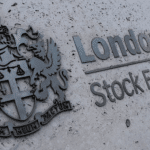The tariff war rumbles on…
Here we go again. After a short respite, the White House upped its stake in the tariff war against Europe (again). President Trump, on his media platform Truth Social (www.truthsocial.com), blasted the European Union for its ‘totally unacceptable’ trade surplus. Negotiations, he added, are ‘going nowhere’. Therefore, from 1 June, the president recommends a mammoth tariff rate of 50 percent (see below).
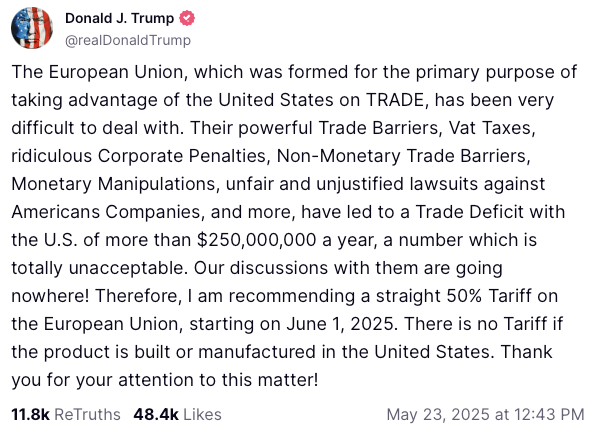
Source: Truthsocial.com
At a glance, these are tough words, not unlike his previous strong-arm negotiation tactics. But investors, after weeks of digesting Trump’s volatile tariff actions, appear to have a different take on the latest salvo. The numbers tell the story. The S&P 500 and Nasdaq Composite slipped a mere 0.67 and 1.00 percent, respectively when President Trump tweeted the above. Europe was modestly weaker. The German DAX and French CAC Index lost 1.54 and 1.65 percent, respectively.
So, should we be worried about a repeat of Trump’s Tariff Tantrums? Seemingly, the market is not concerned at all. DAX is trading at an optimistic level, just below its all-time highs (see below). Mind you, DAX’s gain is on top of the rally in EUR/USD exchange rate. Even the UK FTSE 100 is not far off its record high at 8,900. It dropped a mere 0.24 percent on Friday.

Why are investors brushing all these threatening tariffs tweets aside? The answer lies with this acronym: TACO. Most of these big, scary, numbers tend to melt away. Cool heads and rational calculations lead to trade/tariff deals eventually. Investors assume, rightly or wrongly, that this pattern will prevail.
Indeed, just three days later, the new date for the higher EU tariffs is set to July 9.
Bond investors are still concerned about inflation and deficit
Tariff aside, what got most investors concerned is still inflation. A regime change in inflation across the board is noted. Higher tariff rates will only fuel this trend.
For example the US April inflation rate came in lower than expected (2.3 percent) but Treasuries kept falling. Turn your attention to this Treasury Inflation Protection (TIP) breakeven rate. Briefly, this rate measures the yield difference between nominal and TIPS bonds of similar maturities. It contains some information about market’s inflation expectations. The regime change in the B/E rate around COVID is quite clear. Money printing has consequences.
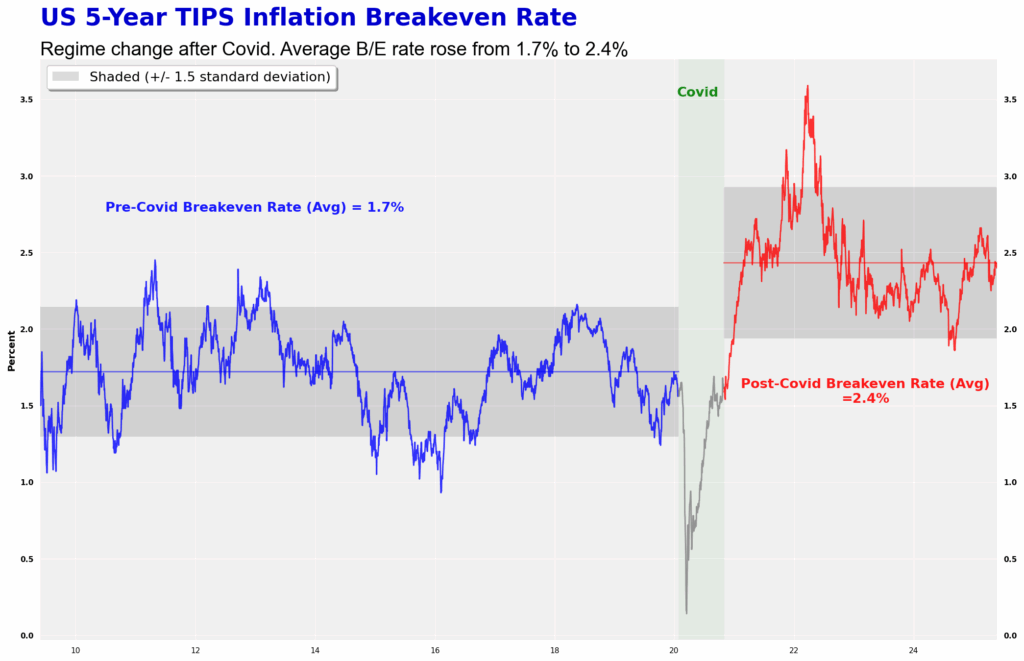
Source: Data (fred.stlouisfed.org); Chart Template (Bianco Research/John Mauldin)
Slowly but surely, investors are waking up to the threat of persistent inflation. More inflation-protected bonds, such as the iShares TIPS Bond ETF (TIPS, factsheet), over that of long-maturity bonds such as iShares Long-Maturity Treasuries (TLT). The latter slumped to multi-year lows last week.
Another factor weighing on US government bonds is the future deficit. The latest tax cut, dubbed ‘OBBB Act’ (One Big Beautiful Bill, summary), could cost more than anticipated in the next decade.
Meanwhile, other inflation hedge instruments like gold – and Bitcoin – are also heading north. Last week, the precious metal rebounded nearly 5 percent to $3,350. Bitcoin scaled new heights, to $112K.
With this increasingly-volatile macro backdrop in mind, we turn to emerging markets.
Time to Buy into Emerging Markets?
Emerging markets are highly cyclical.
When the global economy is booming (eg, 2002-2008), EMs perform well. But in the new, tariff-laced macro environment, should we look at EMs at all? What are the pros and cons of this strategy?
Pros (investing in EMs)
- Higher nominal growth
- Increasing trade between EMs
- Reasonably valued; fast-growing companies
Cons
- Tariffs impact on global trade, esp. good exports
- Inflation (see, eg, IMF Global Consumer Prices)
- Weak currencies
According to the investment house GMO (www.gmo.com), emerging markets with a value slant (‘Emerging Value’) is predicted to deliver long-term real returns above that of US Large and Small-cap sectors (see below). This is logical. US equities are expensive these days. The US CAPE-Shiller Ratio is near the highest level in decades. Thus some tactical allocation to EM equities is perhaps warranted. But how should we go about implementing this?
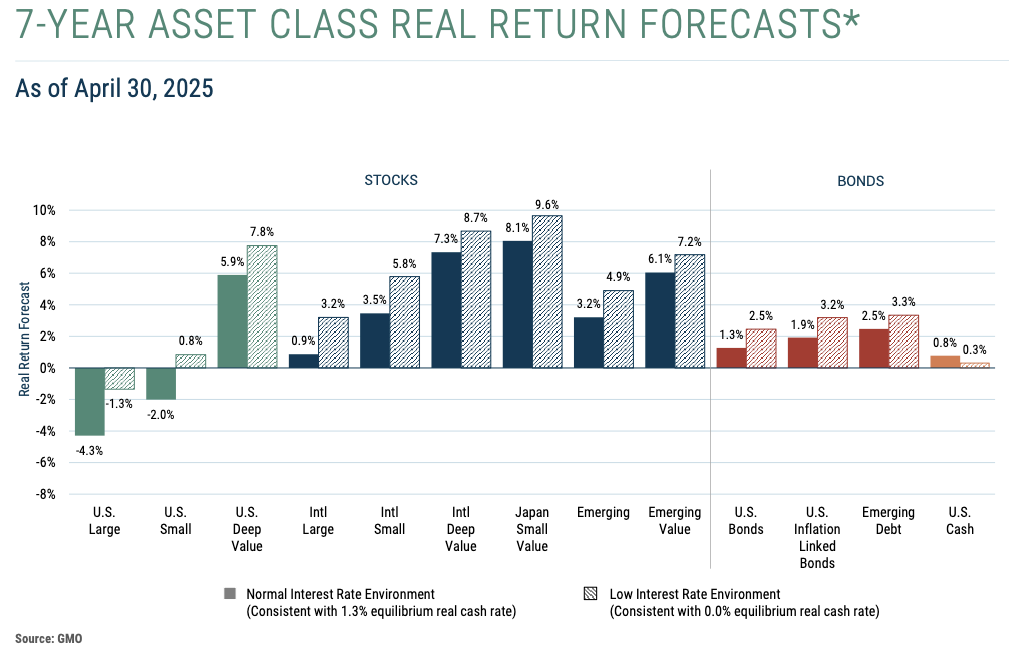
Source: GMO (April 2025)
Perhaps we should start with some of the largest EMs economies, such as China, India, Brazil, Indonesia, etc. Emerging market is a generic term. It encompasses many countries around the world, each with distinct growth rates, governance frameworks and diverse market themes.
Larger economies mean larger companies. Better liquidity for investors. Top flight companies from these large economies easily rival that from developed nations. For example, China has Tencent ($600b m-cap), Alibaba ($289b) or BYD ($165b) while India produces Reliance Ind. ($220b), HDFC Bank ($188b) or Tata Consultancy ($150b).
Large-cap Chinese companies have spent the last year trying to break out from their technical bases (see iShares China Large-cap, US:FXI). The combination of the ‘Deep Seek’ catalyst and steady exports held the Chinese stock market steady. We may see further rallies from here.
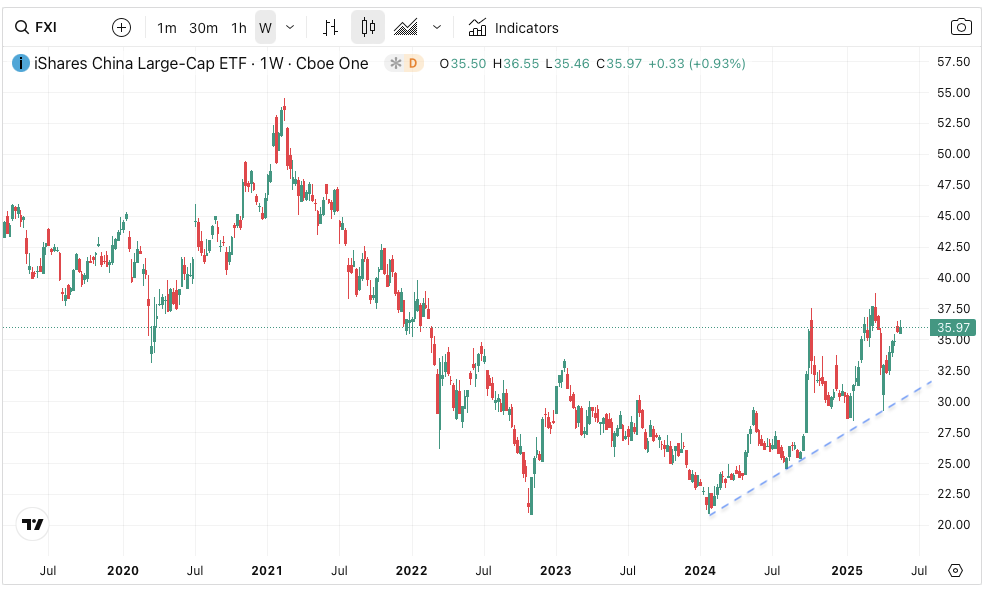
Trendwise, India is showing excellent bullishness. The country possesses a massive population of 1.46 billion. All potential consumers with a relatively young age profile (see Rise of Indian Consumers). Sensex, the local equity index, is consolidating from its all-time high. One equity instrument to ride the wave in the UK is the JP Morgan Indian Investment Trust (LSE:JII), which is flirting with new all-time highs (see below).

Brazil is a country blessed with a wide range of commodities. Naturally, it is a commodity powerhouse. The Commodity Supercycle heavily influences the growth rate there. But its currency and stock market are not doing well. Real depreciated to new long-term lows against USD a few months back; while the local stock market is languishing near multi-year lows. Perhaps it is a market to underweight for now.
Some EMs do underperform for an extended time. But there are enough markets to choose from. Focus on the more bullish trends and cull the underperforming ones.
Alternatively, investors may choose the ETF route to buy into EMs.
For example, the US iShares Core MSCI EM (US:IEMG, factsheet) is an $83 billion ETF that tracks the MSCI EM Index. The top three holdings are Taiwan Semiconductor, Tencent and Alibaba. With a large portion of the funds in Chinese and Indian stocks (48 percent), it could be a good choice to buy into the largest two emerging markets.


Jackson is a core part of the editorial team at GoodMoneyGuide.com.
With over 15 years of industry experience as a financial analyst, he brings a wealth of knowledge and expertise to our content and readers.
Previously, Jackson was the director of Stockcube Research as Head of Investors Intelligence. This pivotal role involved providing market timing advice and research to some of the world’s largest institutions and hedge funds.
Jackson brings a huge amount of expertise in areas as diverse as global macroeconomic investment strategy, statistical backtesting, asset allocation, and cross-asset research.
Jackson has a PhD in Finance from Durham University and has authored over 200 guides for GoodMoneyGuide.com.
To contact Jackson, please ask a question in our financial discussion forum.


